Distribution of Dislocations near the Interface in AlN Crystals Grown on Evaporated SiC Substrates
Abstract
:1. Introduction
2. Experimental
3. Results
3.1. Synchrotron Imaging and X-ray Diffractometry
3.2. TEM Characterisation
4. Discussion
5. Conclusions
Acknowledgments
Author Contributions
Conflicts of Interest
References
- Hartmann, C.; Wollweber, J.; Dittmar, A.; Irmscher, K.; Kwasniewski, A.; Langhans, F.; Neugut, T.; Bickermann, M. Preparation of bulk AlN seeds by spontaneous nucleation of freestanding crystals. Jpn. J. Appl. Phys. 2013, 52, 08JA06-1–08JA06-6. [Google Scholar] [CrossRef]
- Sumathi, R.; Gille, P. Development and progress in bulk c-plane AlN single-crystalline template growth for large-area native seeds. Jpn. J. Appl. Phys. 2013, 52, 08JA02-1–08JA02-4. [Google Scholar] [CrossRef]
- Dalmau, R.; Moody, B.; Xie, J.; Collazo, R.; Sitar, Z. Characterization of dislocation arrays in AlN single crystals grown by PVT. Phys. Status Solidi A 2011, 208, 1545–1547. [Google Scholar] [CrossRef]
- Zhou, T.; Raghothamachar, B.; Wu, F.; Dalmau, R.; Moody, B.; Craft, S.; Schlesser, R.; Dudley, M.; Sitar, Z. Characterization of threading dislocations in PVT-grown AlN substrates via X-ray topography and ray tracing simulation. J. Electron. Mater. 2014, 43, 838–842. [Google Scholar] [CrossRef]
- Herro, Z.; Zhuang, D.; Schlesser, R.; Sitar, Z. Growth of AlN single crystalline boules. J. Cryst. Growth 2010, 312, 2519–2521. [Google Scholar] [CrossRef]
- Miyanaga, M.; Mizuhara, N.; Fujiwara, S.; Shimazu, M.; Nakahata, H.; Kawase, T. Evaluation of AlN single-crystal grown by sublimation method. J. Cryst. Growth 2007, 300, 45–49. [Google Scholar] [CrossRef]
- Nagai, I.; Kato, T.; Miura, T.; Kamata, H.; Naoe, K.; Sanada, K.; Okumura, H. AlN bulk single crystal growth on 6H-SiC substrates by sublimation method. J. Cryst. Growth 2010, 312, 142–149. [Google Scholar] [CrossRef]
- Mokhov, E.; Izmaylova, I.; Kazarova, O.; Wolfson, A.; Nagalyuk, S.; Litvin, D.; Vasiliev, A.; Helava, H.; Makarov, Y. Specific features of sublimation growth of bulk AlN crystals on SiC wafers. Phys. Status Solidi C 2013, 10, 445–448. [Google Scholar] [CrossRef]
- Kaganer, V.M.; Brandt, O.; Trampert, A.; Ploog, K.H. X-ray diffraction peak profiles from threading dislocations in GaN epitaxial films. Phys. Rev. B 2005, 72, 045423. [Google Scholar] [CrossRef]
- Wolfson, A. Spontaneous detachment of a sublimation-grown AlN layer from an SiC-6H substrate. Semiconductors 2009, 43, 818–819. [Google Scholar] [CrossRef]
- Dalmau, R.; Schlesser, R.; Rodriguez, B.J.; Nemanich, R.J.; Sitar, Z. AlN bulk crystals grown on SiC seeds. J. Cryst. Growth 2005, 281, 68–74. [Google Scholar] [CrossRef]
- Yamakawa, M.; Murata, K.; Iwaya, M.; Takeuchi, T.; Kamiyama, S.; Akasaki, I.; Amano, H.; Azuma, M. Freestanding highly crystalline single crystal AlN substrates grown by a novel closed sublimation method. APEX 2011, 4, 045503-1–045503-3. [Google Scholar] [CrossRef]
- Argunova, T.S.; Gutkin, M.Y.; Mokhov, E.N.; Kazarova, O.P.; Lim, J.-H.; Scheglov, M.P. Prevention of AlN crystal from cracking on SiC substrates by evaporation of the substrates. Phys. Solid State 2015, 57, 2473–2478. [Google Scholar] [CrossRef]
- Argunova, T.S.; Gutkin, M.Y.; Kazarova, O.P.; Mokhov, E.N.; Nagalyuk, S.S.; Je, J.H. Synchrotron X-ray study on crack prevention in AlN crystals grown on gradually decomposing SiC substrates. In Silicon Carbide and Related Materials; Chaussende, D., Ferro, G., Eds.; Trans. Tech. Publications Ltd.: Zürich, Switzerland, 2015; Volume 821–823, pp. 1011–1014. [Google Scholar]
- Argunova, T.S.; Gutkin, M.Y.; Shcherbachev, K.D.; Je, J.H.; Lim, J.-H.; Kazarova, O.P.; Mokhov, E.N. Microstructure and strength of AlN-SiC interface studied by synchrotron X-rays. J. Mater. Sci. 2017, 52, 4244–4252. [Google Scholar] [CrossRef]
- Avdeev, O.V.; Chemekova, T.Y.; Mokhov, E.N.; Nagalyuk, S.S.; Helava, H.; Ramm, M.G.; Segal, A.S.; Zhmakin, A.I.; Makarov, Y.N. Development of 2 inch AlN Substrates Using SiC Seeds. In Modern Aspects of Bulk Crystal and Thin Film Preparation; Kolesnikov, N., Ed.; InTech: Rijeka, Croatia, 2012; pp. 213–262. [Google Scholar]
- Epelbaum, B.M.; Heimann, P.; Bickermann, M.; Winnacker, A. Comparative study of initial growth stage in PVT growth of AlN on SiC and on native AlN substrates. Phys. Status Solidi C 2005, 2, 2070–2073. [Google Scholar] [CrossRef]
- Stein, R.A.; Lanig, P.; Leibenzeder, S. Influence of surface energy on the growth of 6H-SiC and 4H-SiC polytypes by sublimation. Mater. Sci. Eng. 1992, B11, 69–71. [Google Scholar] [CrossRef]
- Bowen, D.K.; Tanner, B.K. High Resolution X-ray Diffractometry and Topography; Taylor & Francis Ltd.: London, UK, 1998. [Google Scholar]
- Birkholz, M. Thin Film Analysis by X-ray Scattering; Wiley-VCH Verlag GmbH and Co., KGaA: Weinheim, Germany, 2006. [Google Scholar]
- Okumura, H.; Kimoto, T.; Suda, J. Formation mechanism of threading-dislocation array in AlN layers grown on 6H-SiC (0001) substrates with 3–Bilayer-high surface steps. Appl. Phys. Lett. 2014, 105, 071603-1–071603-4. [Google Scholar] [CrossRef]


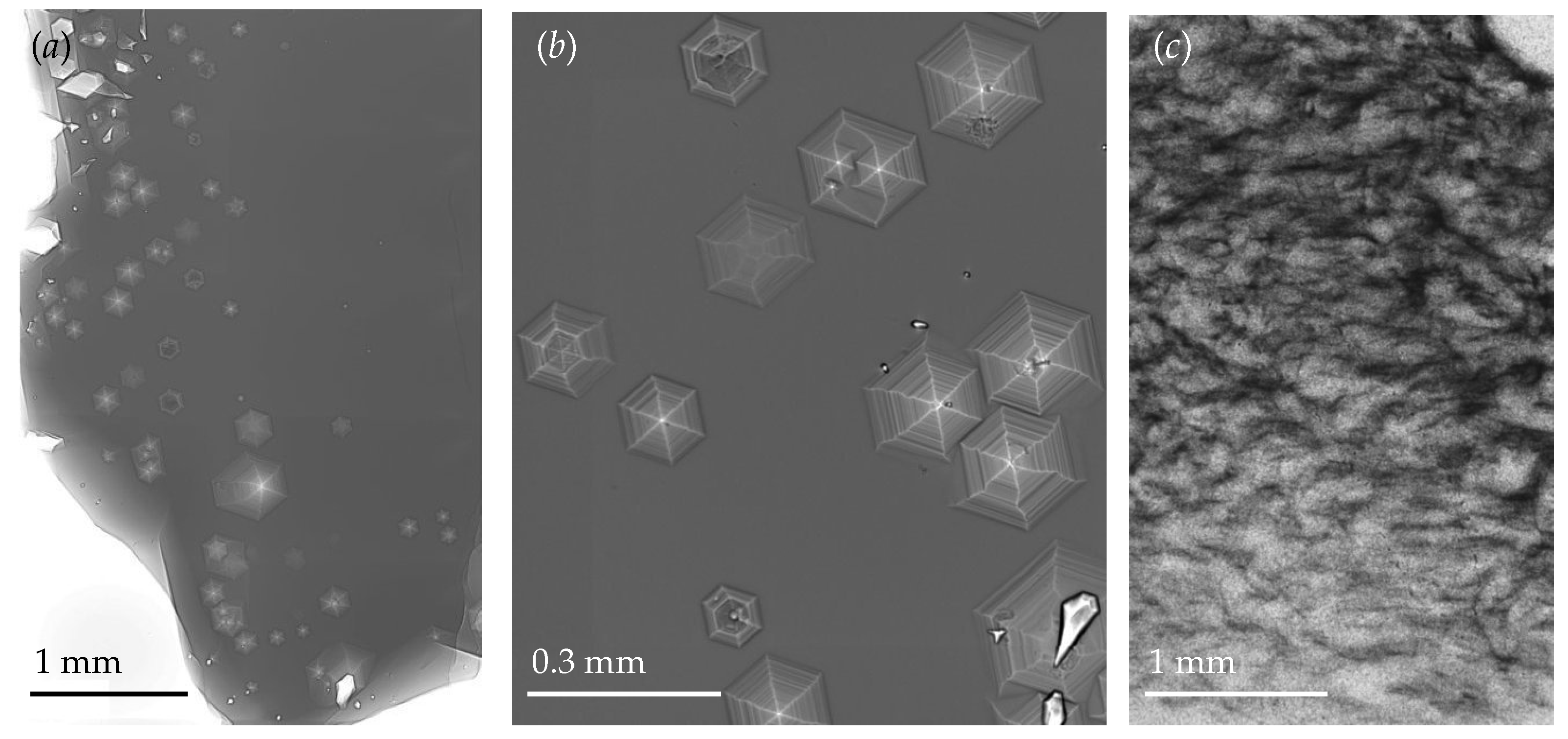
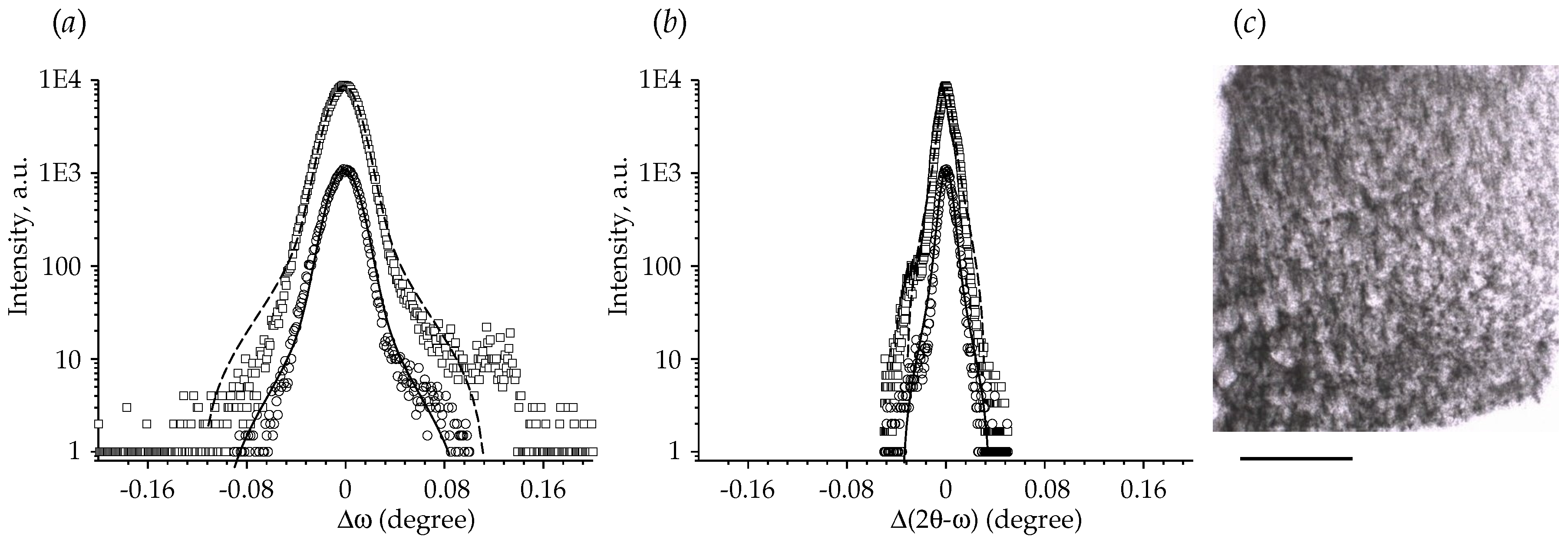
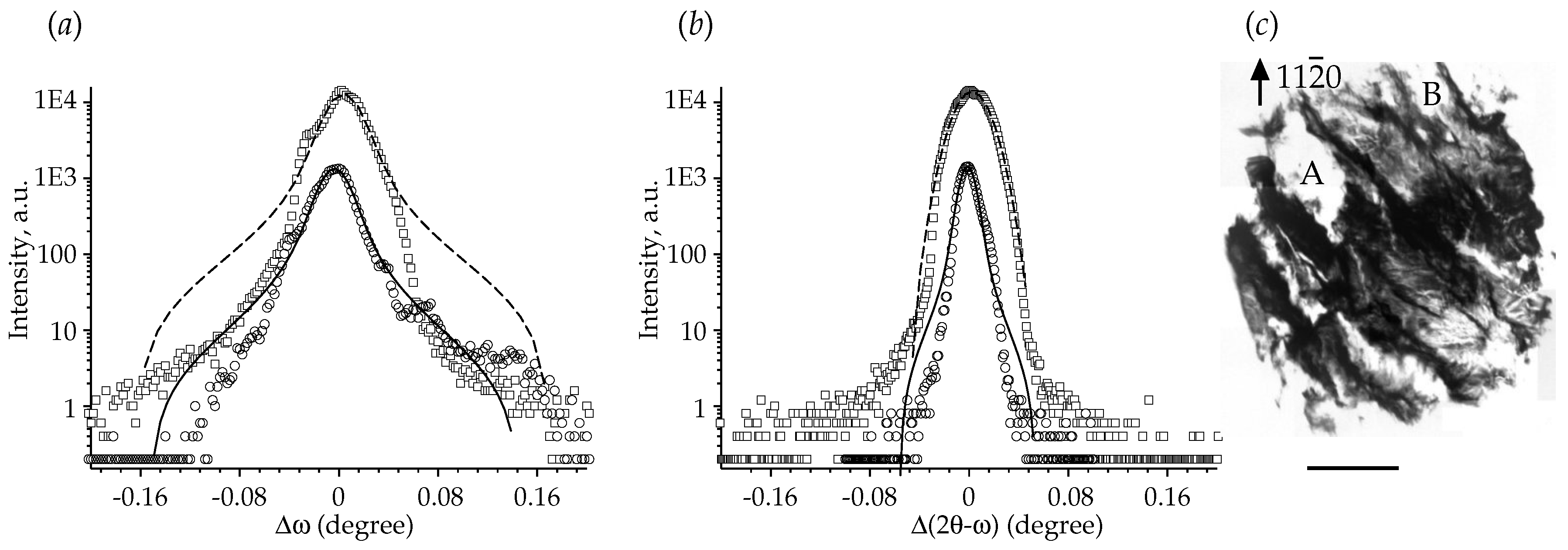
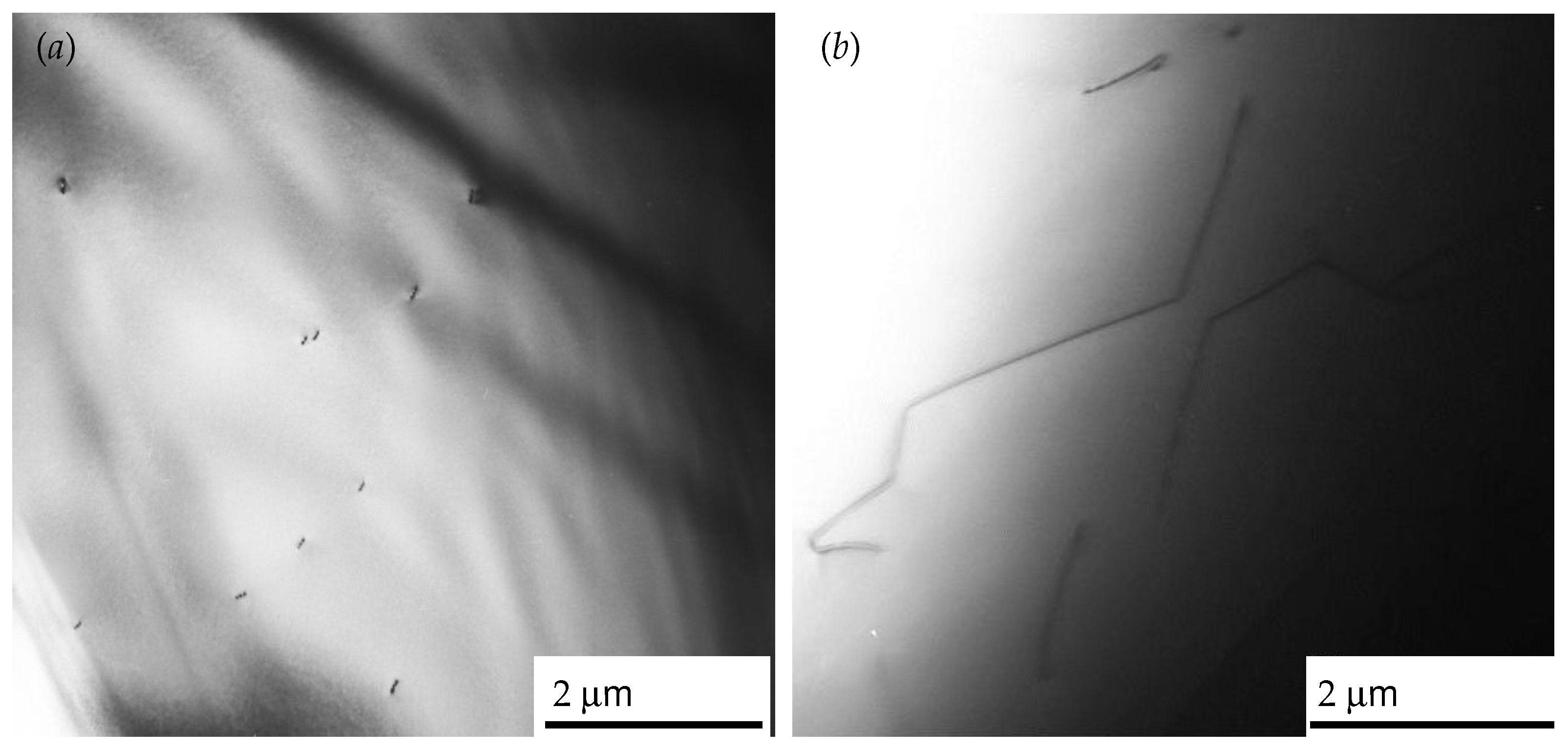
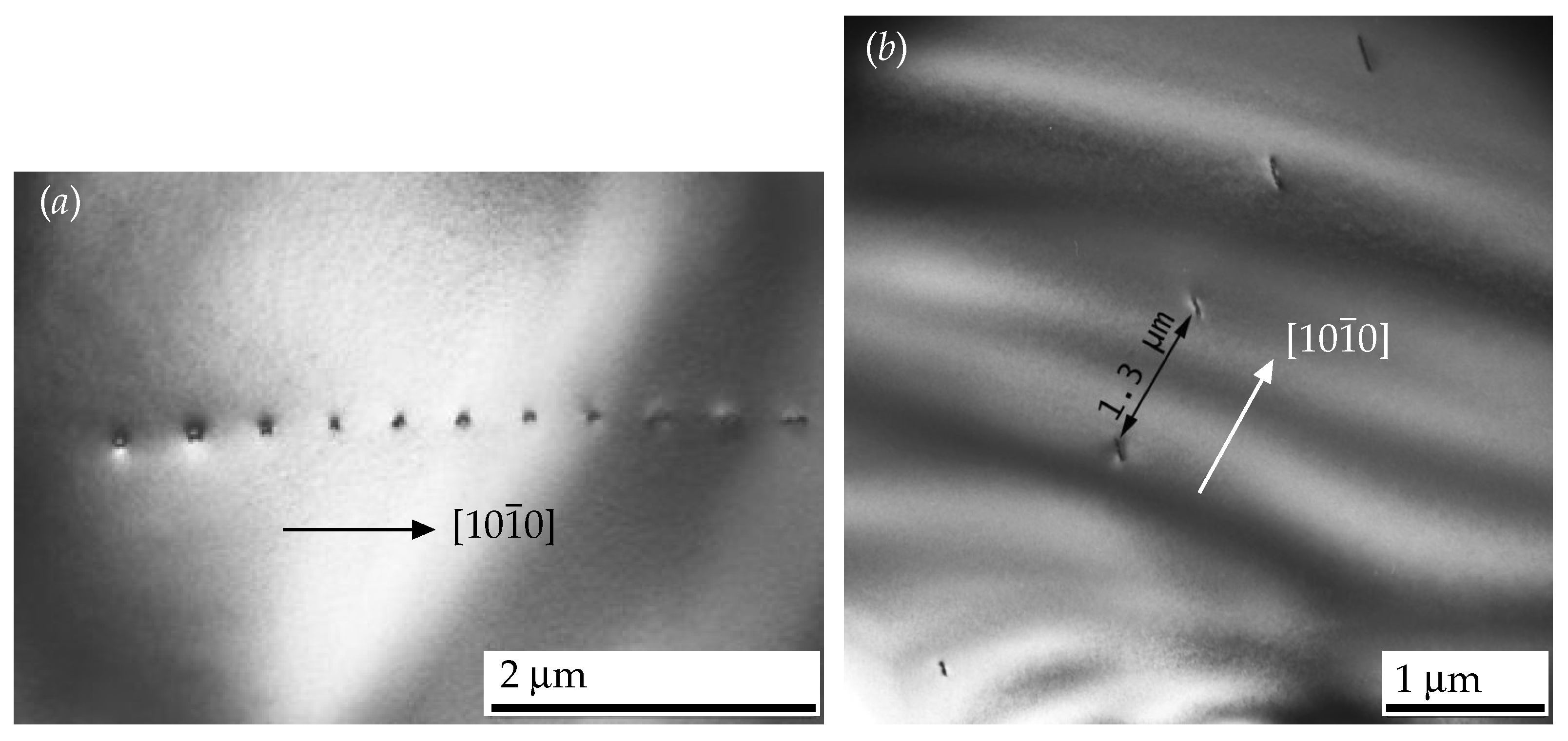

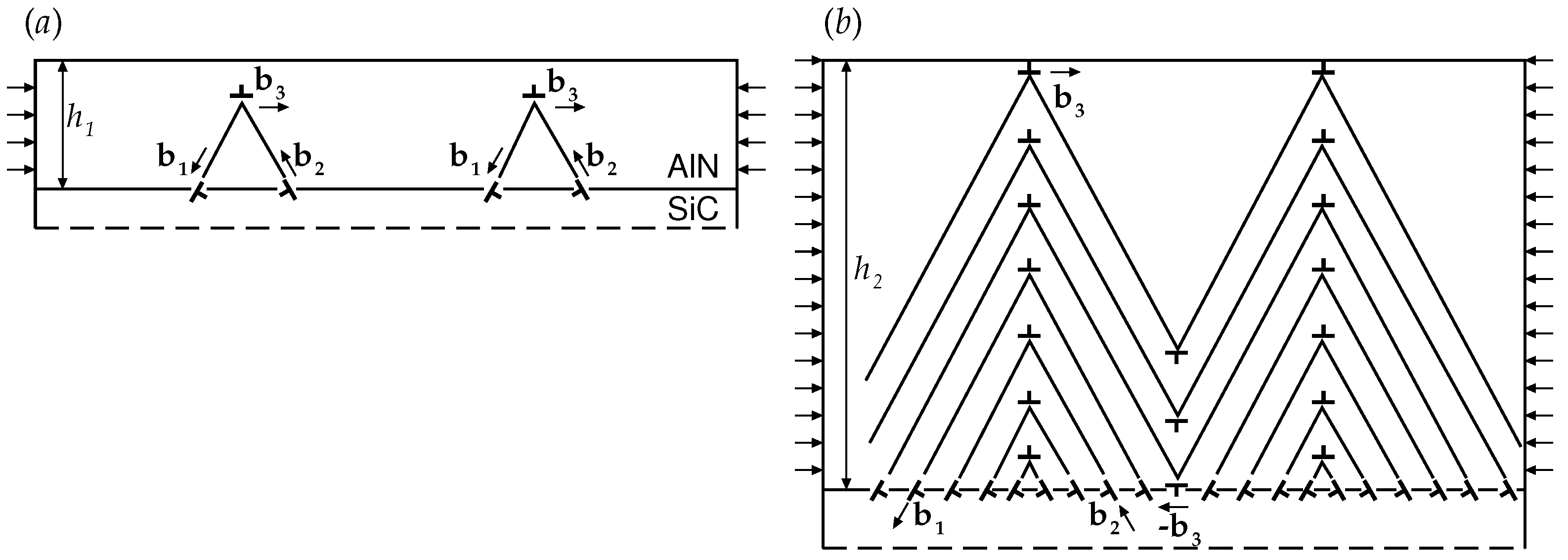
© 2017 by the authors. Licensee MDPI, Basel, Switzerland. This article is an open access article distributed under the terms and conditions of the Creative Commons Attribution (CC BY) license (http://creativecommons.org/licenses/by/4.0/).
Share and Cite
Argunova, T.S.; Gutkin, M.Y.; Je, J.H.; Kalmykov, A.E.; Kazarova, O.P.; Mokhov, E.N.; Mikaelyan, K.N.; Myasoedov, A.V.; Sorokin, L.M.; Shcherbachev, K.D. Distribution of Dislocations near the Interface in AlN Crystals Grown on Evaporated SiC Substrates. Crystals 2017, 7, 163. https://doi.org/10.3390/cryst7060163
Argunova TS, Gutkin MY, Je JH, Kalmykov AE, Kazarova OP, Mokhov EN, Mikaelyan KN, Myasoedov AV, Sorokin LM, Shcherbachev KD. Distribution of Dislocations near the Interface in AlN Crystals Grown on Evaporated SiC Substrates. Crystals. 2017; 7(6):163. https://doi.org/10.3390/cryst7060163
Chicago/Turabian StyleArgunova, Tatiana S., Mikhail Yu. Gutkin, Jung Ho Je, Alexander E. Kalmykov, Olga P. Kazarova, Evgeniy N. Mokhov, Kristina N. Mikaelyan, Alexander V. Myasoedov, Lev M. Sorokin, and Kirill D. Shcherbachev. 2017. "Distribution of Dislocations near the Interface in AlN Crystals Grown on Evaporated SiC Substrates" Crystals 7, no. 6: 163. https://doi.org/10.3390/cryst7060163





